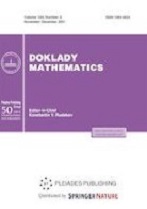|
MATHEMATICS
Three infinite families of Shilla graphs do not exist
A. A. Makhneva, I. N. Belousova, M. P. Golubyatnikova, M. S. Nirovab
a N.N. Krasovskii Institute of Mathematics and Mechanics, Ural Branch of the Russian Academy of Sciences, Yekaterinburg, Russia
b Kabardino-Balkar State University, Nalchik, Russia
Abstract:
A distance-regular graph of diameter 3 with the second eigenvalue $\theta_1=a_3$ is called a Shilla graph. For a Shilla graph $\Gamma$, the number $a=a^3$ divides $k$ and we set $b=b(\Gamma)=k/a$. Three infinite families of Shilla graphs with the following admissible intersection arrays were found earlier: $\{b(b^2-1),b^2(b-1),b^2;1,1,(b^2-1)(b-1)\}$ (I.N. Belousov), $\{b^2(b-1)/2,(b-1)(b^2-b+2)/2,b(b-1)4;1,b(b-1)/4,b(b-1)^2/2\}$ (Koolen, Park), and $\{(s+1)(s^3-1),s^4,s^3;1,s^2,s(s^3-1)\}$. In this paper, it is proved that, in the first family, there exists a unique graph, namely, a generalized hexagon of order 2, whereas there are no graphs in the second or third families.
Keywords:
distance-regular graph, Shilla graph, triple intersection numbers.
Received: 30.03.2021
Revised: 30.03.2021
Accepted: 27.04.2021
Citation:
A. A. Makhnev, I. N. Belousov, M. P. Golubyatnikov, M. S. Nirova, “Three infinite families of Shilla graphs do not exist”, Dokl. RAN. Math. Inf. Proc. Upr., 498 (2021), 45–50; Dokl. Math., 103:3 (2021), 133–138
Linking options:
https://www.mathnet.ru/eng/danma175 https://www.mathnet.ru/eng/danma/v498/p45
|


| Statistics & downloads: |
| Abstract page: | 123 | | Full-text PDF : | 20 | | References: | 25 |
|





 Contact us:
Contact us: Terms of Use
Terms of Use
 Registration to the website
Registration to the website Logotypes
Logotypes








 Citation in format
Citation in format 